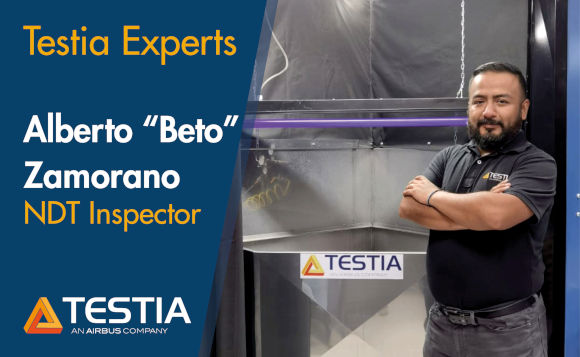In our article series “Testia Experts”, we present short interviews with our employees – the experts that really make Testia what it is. In this issue, Alberto Zamorano gives an insight into his job as an NDT Inspector for Testia Mexico in Querétaro.
 Beto, what is your background on NDT and how does it fit into Testia?
Beto, what is your background on NDT and how does it fit into Testia?
All started when I was studying to become an Aeronautic Technician. During my internship I was in a MRO company doing NDT. So that was my first approach to non-destructive testing: assisting the Level 2 Inspectors. My first NDT training was in 2001 for Eddy Current, after that I continued my training for PT, MT, UT and RT.
In 2008 I got my NAS 410 / EN 4179 certification as Level 2 for PT and MT, I was working for Safran MRO Facility at that time. By 2012 I got my certifications for ET, UT and some emerging NDT methods like Nital Etch, Titanium Etch and Barkhausen Noise. Back in 2015 I became part of the Testia team in México.
My main activities at Testia are related to the training for Penetrant Testing and Magnetic Particle Testing: From the development of each training course, its manuals and the training for NDT Inspectors. I am also involved in the update for NDT procedures and the support to customers for technical matters related to their Penetrant Testing and Magnetic Particle Testing inspections.
I really enjoy to train people, it is so pleasant to share my knowledge and experience with other Inspectors.
What are usual applications of Penetrant Testing in aerospace? What was the most unusual aircraft part that you have ever inspected with PT?
This will always be based on what is required by the designer of the specific component. Talking about MRO, the most typical flaws that I have detected are the cracks formed as a result of the forces acting over the component during operation. For components during manufacturing process, there could be flaws on them as well, due to a bad machining process or a bad surface treatment process.
The most unusual component that I had inspected using Penetrant Testing was a portable oxygen tank that was part of the emergency equipment of a helicopter. That aircraft had a very rough landing, which hurt part of its structure. The tanks was close to the damaged area, so, after the repairs were made, I performed the inspection all over the area, including the tank.
In 2021, the ASTM-E1417M-21 standard for penetrant testing was updated. What are the major changes?
The main changes in ASTM-E1417M-21 standard are the frequency in the controls for the materials and the way that UV-A light sources are classified. The re-classification for UV-A sources improves the control for the light used during inspections.
In the aerospace industry, most of the materials used for Penetrant Testing are fluorescent, so the UV-A light source is quite critical in the process, since it will allow inspectors to see the indications – in other words, it will allow them to detect the flaws.
The previous lighting technology was based on mercury vapor and it works quite different to LED in terms of illumination. When LED technology came on board for NDT applications, some of the parameters and the way to measure them required an update in the new version of the standard.
Are you interested in also becoming a Testia expert? Visit our career page to find out about our current job offers!

